British Shorthair
The British Shorthair is the pedigreed version of the traditional British domestic cat, with a distinctively stocky body, dense coat, and broad face. The most familiar color variant is the "British Blue", with a solid grey-blue coat, orange eyes, and a medium-sized tail. The breed has also been developed in a wide range of other colours and patterns, including tabby and colorpoint.
| British Shorthair | |
|---|---|
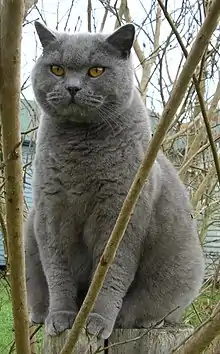 Classic ‘British Blue’ Shorthair | |
| Origin | United Kingdom |
| Breed standards | |
| CFA | standard |
| FIFe | standard |
| TICA | standard |
| WCF | standard |
| FFE | standard |
| AACE | standard |
| ACF | standard |
| ACFA/CAA | standard |
| CCA-AFC | standard |
| Domestic cat (Felis catus) | |
It is one of the most ancient cat breeds known. In modern times, it remains the most popular pedigreed breed in its native country, as registered by the UK's Governing Council of the Cat Fancy (GCCF). A quarter of all kittens registered with the GCCF each year are British Shorthairs, making the British the most popular pedigree cat in the UK.[1]
The breed's good-natured appearance and relatively calm temperament make it a frequent media star, notably as the inspiration for John Tenniel's famous illustration of the Cheshire Cat from Alice in Wonderland. The Cat Fanciers' Association profile reads: "When gracelessness is observed, the British Shorthair is duly embarrassed, quickly recovering with a 'Cheshire cat smile'."[2]
History
The origins of the British Shorthair most likely date back to the first century AD, making it one of the most ancient identifiable cat breeds in the world. These cats were imported by the Romans who kept them to keep the camps clear of snakes, mice and insects.
These cats then interbred with the local European wildcat population. Over the centuries, their naturally isolated descendants developed into distinctively large, robust cats with a short but very thick coat, to better withstand conditions on their native islands. Based on artists' representations, the modern British Shorthair is unchanged from this initial type.[3]
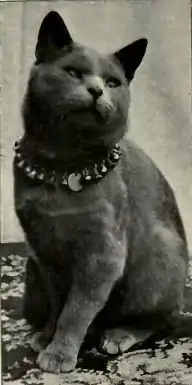
Selective breeding of the best examples of the type began in the nineteenth century, with emphasis on developing the unusual blue-grey variant called the "British Blue" or "English type" (to distinguish it from the more fine-boned "Russian type"). Some sources directly credit UK artist, and pioneering cat fancier, Harrison Weir with the initial concept of standardising the breed. Others suggest a group of breeders may have been involved. The new British Shorthair was featured at the first-ever cat show, organised by Weir and held at the Crystal Palace in London in 1871, and enjoyed great initial popularity.[4]
By the 1900s with the advent of the newly imported Persian and other long-haired breeds, the British Shorthair had fallen out of favour, and breeding stock had become critically rare by World War I. At least partially to alleviate this, British Shorthair breeders mixed Persians into their bloodlines. The genes thus introduced would eventually become the basis for the British Longhair. At the time, any long-haired cats produced were placed into the Persian breeding program. As all cats with the blue colouration were then judged together as variants on a de facto single breed. The Blue Shorthair, outcrossings of the British with the Russian Blue were also common.[3]

After the war, in an attempt to maintain the breed standard, the GCCF decided to accept only third-generation Persian/British Shorthair crosses. This contributed to another shortage of pure breeding stock by World War II, at which point the Persian and Russian Blue were reintroduced into the mix. British Shorthair breeders also worked with the French Chartreux, another ancient breed, which although genetically unrelated to the British Blue, is a very similar cat in appearance. Breeders worked to re-establish the true British type, and by the late 1970s, the distinctive British Shorthair had achieved formal recognition from both the Cat Fanciers' Association (CFA) and The International Cat Association (TICA).[3] According to the GCCF's 2013 registry data, it is once again the most popular pedigreed breed in its native country.[5]
Description
Appearance
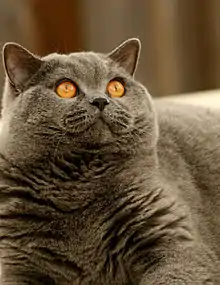
The British Shorthair is a relatively powerful-looking large cat, having a broad chest, strong thick-set legs with rounded paws and a medium-length, blunt-tipped tail. The head is relatively large and rounded, with a short muzzle, broad cheeks (most noticeable in mature males, who tend to develop prominent jowls) and large round eyes that are deep coppery orange in the British Blue and otherwise vary in colour depending on the coat. Their large ears are broad and widely set.[6]
The British Blue variant can often be confused with the grey Scottish Fold, a breed closely related to the British Shorthair. However, the Shorthair can be characterised by having its pointy triangle ears, whereas the Fold has softer, folded ears.
They are slow to mature in comparison with most cat breeds, reaching full physical development at approximately three years of age. Unusually among domestic cats they are a noticeably sexually dimorphic breed, with males averaging 9–17 lb (4.1–7.7 kg) and females 7–12 lb (3.2–5.4 kg).[7][8]
Coat, colour, and patterns
The British Shorthair's coat is one of the breed's defining features. It is very dense but does not have an undercoat; thus, the texture is plush rather than woolly or fluffy, with a firm, "crisp" pile that breaks noticeably over the cat's body as it moves.[3][6]
Although the British Blue remains the most familiar variant, British Shorthairs have been developed in many other colours and patterns. Black, blue, white, red, cream, silver, golden and—most recently—cinnamon and fawn are accepted by all official standards, either solid or in colourpoint, tabby, shaded and bicolour patterns; the GCCF, FIFe and TICA also accept chocolate and its dilute lilac, disallowed in the CFA standard.[9] All colours and patterns also have tortoiseshell variants.[6]
The Tabby patterns include:[10] Classic Tabby, Mackerel Tabby, Spotted & Ticked Tabby. The non-tabby patterns include: Tortoiseshell, Bi-Colour, Van patterns Bi-Colour & White, Smoke, Tipped & Colourpointed.
 4-month-old golden shaded male kitten
4-month-old golden shaded male kitten 5-month-old lilac female kitten
5-month-old lilac female kitten Blue bicolour adult male
Blue bicolour adult male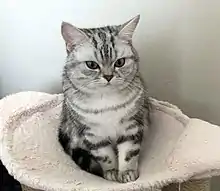 6-month-old silver classic tabby male kitten
6-month-old silver classic tabby male kitten British shorthair in silver coat color
British shorthair in silver coat color
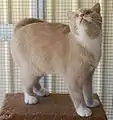 Fawn and white bicolour adult male
Fawn and white bicolour adult male Seal point with white adult female
Seal point with white adult female Dilute blue-cream calico adult female
Dilute blue-cream calico adult female 6 month old male blue cream, Leo-lenzie
6 month old male blue cream, Leo-lenzie 16 year old British shorthair, Harrison
16 year old British shorthair, Harrison
Temperament
They are an easygoing and dignified breed, not as active and playful as many but sweet-natured and devoted to their owners, making them a favourite of animal trainers. They tend to be safe around other pets and children since they will tolerate a fair amount of physical interaction, but as a rule do not like to be picked up or carried. They require only minimal grooming and take well to being kept as indoor-only cats; however, they can be prone to obesity unless care is taken with their diet.[3][7]
Health
The UK breed committee considers the British Shorthair a long-lived cat, with a life expectancy of 14–20 years.[11] Vet clinic data from England shows a median lifespan of 11.8 years.[12] Swedish insurance data puts the median lifespan of the breed at > 12.5 years. 82% of British Shorthairs lived to 10 years or more and 54% lived to 12.5 years or more.[13]
Hypertrophic cardiomyopathy (HCM) can be a problem in the breed. A Danish prevalence study with more than 329 cats showed that 20.4% of males and 2.1% of the females had HCM. On top of this 6.4% of males and 3.5% of females were judged to be equivocal.[14] HCM testing of males used for breeding is now mandatory for breeders organised under the Danish Fife member, Felis Danica.[15]
The breed is thought to be at high risk of polycystic kidney disease (PKD).[16] A DNA test lab has noted a significant decrease of the PKD mutations in tested populations. Carrier frequency is now at 1%.[17]
Potential Health Problems
This disease forms a cyst in the cat's kidney, causing organ failure.[18]Polycystic kidney disease can be detected through genetic testing or ultrasound. There is no cure for polycystic kidney disease but there are drugs that can alleviate the effects and its advancement.
The heart muscle thickens which limits the amount of blood that is pumped, leading to blood clots and health failure.[18]Cardiomyopathy can be detected through ultrasound, EEG, and x-ray. Drugs can alleviate and slow down the advancement of the disease.
In popular culture

- Happycat (also known as the "I Can Has Cheezburger?" cat), a male British Blue, is the star of a meme started on the Something Awful forums. The original picture apparently came from the front page of happycat.ru, a Russian cat food company.
- Sir John Tenniel's famous illustration of the Cheshire Cat in Alice's Adventures in Wonderland by Lewis Carroll is based on the British Shorthair.
- Smokey the cat in E.B. White's children's novel Stuart Little was a British Blue.
- A silver tabby British Shorthair is the mascot of Whiskas brand cat food.
- Winston Churchill (Church) from Pet Sematary is a British Blue.
- Arlene, Garfield the cat's girlfriend, is portrayed as a British Blue in Garfield: The Movie.
- Mick, from Kamen Rider W, is a British Shorthair who can turn into the Smilodon Dopant.
- Ruby in the film adaptation of the memoir Girl, Interrupted by Susanna Kaysen is a British Blue.
- Puss in Boots from the Shrek franchise is described as and closely resembles a British Shorthair, although he speaks with a strong Spanish accent.
- Tsim Tung Brother Cream, a famous Hong Kong cat, was a cream and white British Shorthair.
- Tama (with the Stand, Stray Cat) from the manga JoJo's Bizarre Adventure: Diamond is Unbreakable is stated to be a British Blue.
- British Radio DJ and proud cat dad Chris Moyles owns a pair of British Blue cats called "Chewie" and "Leia" and regularly features their escapades live on air on the Chris Moyles Show on Radio X and also on social media.
- Toby, Ida Greenberg's cat from Desperate Housewives is a British Blue.
References
- "GCCF Online > Cat Breeds > British Shorthair". www.gccfcats.org. Retrieved 2020-11-14.
- Geyer, Georgie Anne. When Cats Reigned Like Kings: On the Trail of the Sacred Cats. Transaction Publishers. p. 219.
- "British Shorthair". The International Cat Association. Archived from the original on October 31, 2017. Retrieved 26 July 2014.
- "British Shorthair Cats | British Shorthair Cat Breed Info & Pictures | petMD". www.petmd.com. Retrieved 2017-04-12.
- "GCCF: Registry data analysis 2013" (PDF). www.gccfcats.org. Governing Council of the Cat Fancy (UK). Archived from the original (PDF) on 28 July 2014. Retrieved 27 July 2014.
- "British Shorthair Breed Standard" (PDF). www.cfainc.org. Cat Fanciers' Association. Retrieved 26 July 2014.
- "CFA: Introduction to the British Shorthair". www.cfainc.org. Retrieved 27 July 2014.
- The International Cat Association – British Shorthair
- "GCCF: British Shorthair breeding policy" (PDF). www.gccfcats.org. Governing Council of the Cat Fancy (UK). 12 Sep 2012. Archived from the original (PDF) on 14 August 2014. Retrieved 27 July 2014.
- "British Shorthair General Type Standard" (PDF). Gccfcats.org. 2018. Retrieved 2 August 2018.
- "Breeding Policy for the British Shorthair" (PDF). British Shorthair Breed Advisory Committee. Archived from the original (PDF) on 14 August 2014. Retrieved 2 November 2014.
- O'Neill, D. G. (2014). "Longevity and mortality of cats attending primary care veterinary practices in England" (PDF). Journal of Feline Medicine and Surgery. 17 (2): 125–33. doi:10.1177/1098612X14536176. PMID 24925771. S2CID 7098747. "n=69, median=11.8, IQR 5.8-16.3, range 0.0-21.0"
- Egenvall, A.; Nødtvedt, A.; Häggström, J.; Ström Holst, B.; Möller, L.; Bonnett, B. N. (2009). "Mortality of Life-Insured Swedish Cats during 1999–2006: Age, Breed, Sex, and Diagnosis". Journal of Veterinary Internal Medicine. 23 (6): 1175–1183. doi:10.1111/j.1939-1676.2009.0396.x. PMC 7167180. PMID 19780926.
- Granström, S.; Nyberg Godiksen, M. T.; Christiansen, M.; Pipper, C. B.; Willesen, J. T.; Koch, J. (2011). "Prevalence of Hypertrophic Cardiomyopathy in a Cohort of British Shorthair Cats in Denmark". Journal of Veterinary Internal Medicine. 25 (4): 866–871. doi:10.1111/j.1939-1676.2011.0751.x. PMID 21736622.
- "Felis Danica". Felisdanica.dk. Retrieved 2014-06-29.
- "Polycystic kidney disease (PKD): Gene test and negative register". International Cat Care. Archived from the original on 2 November 2014. Retrieved 2 November 2014.
- "PKD – Polycystic Kidney Disease – British Shorthair". Antagene. Retrieved 2 November 2014.
- "What to know if you're buying a… British Shorthair cat". www.petplan.co.uk. Retrieved 2020-10-12.
External links
| Look up british shorthair in Wiktionary, the free dictionary. |
| Wikimedia Commons has media related to British Shorthair cats. |